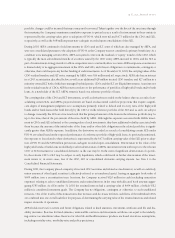American Express 2003 Annual Report Download - page 64
Download and view the complete annual report
Please find page 64 of the 2003 American Express annual report below. You can navigate through the pages in the report by either clicking on the pages listed below, or by using the keyword search tool below to find specific information within the annual report.
(p.62_axp_ financial review)
The provision for losses and benefits for annuities increased 7 percent in 2003 due to higher average inforce levels and the
effect of appreciation in the S&P 500 on equity indexed annuities in 2003 versus depreciation in 2002, partially offset by
the benefit of lower interest crediting rates on fixed annuity contract values and lower costs related to guaranteed minimum
death benefits. In 2002, the annuities provision increased 5 percent reflecting a higher inforce level, increased costs related
to guaranteed minimum death benefits, and the effect of depreciation in the S&P 500 on equity indexed annuities, partially
offset by the benefit of lower interest crediting rates on fixed annuity contract values. Insurance provisions rose in 2003
and 2002, reflecting higher inforce levels and higher claims in both years, partially offset by the benefit of lower interest
crediting rates on fixed life insurance contract values. Investment certificate provisions increased 10 percent in 2003 due to
the effect on the stock market certificate product of appreciation in the S&P 500 in 2003 versus depreciation in 2002 and
higher average investment certificate levels, partially offset by the benefit of lower interest crediting rates. Investment cer-
tificate provisions decreased 44 percent during 2002 due to lower interest crediting rates, partially offset by higher aver-
age investment certificate levels and the effect on the stock market certificate product of depreciation in the S&P 500
during 2002.
Human resources expense increased 10 percent in 2003 primarily due to merit increases, greater employee benefit costs,
higher management incentive costs for employees (excluding financial advisors) and higher field force compensation-
related costs, as well as the effect of the Threadneedle acquisition. Increases in 2003 management incentive costs included
higher stock-based compensation costs from both stock options and increased levels of restricted stock awards. The higher
stock-based compensation expense from stock options reflects the Company’s decision to expense stock options beginning
in 2003. Higher expense related to restricted stock awards reflects the Company’s decision to modify compensation prac-
tices and use restricted stock awards in place of stock options for middle management. These increases were also partially
offset by the effects of a $22 million favorable impact from DAC adjustments in 2003 versus a $1 million favorable impact
in 2002. These DAC adjustments are discussed below. The average number of employees (excluding financial advisors) was
down 4 percent, excluding Threadneedle. Human resources expense declined 4 percent in 2002, reflecting lower field force
compensation-related costs and the benefits of reengineering and cost containment initiatives where the average number of
employees (excluding financial advisors) was down 15 percent from 2001.
Other operating expenses increased in both years. The 2003 increase is due to the impact of fewer capitalized costs in the
first half of 2003 due to the ongoing impact of the comprehensive review of DAC-related practices in 2002, professional
fees related to various industry regulatory matters, the effect of the Threadneedle acquisition and greater legal and acquisi-
tion-related costs. See the DAC and related adjustments discussion below for further information. The 2002 increase reflects
the impact of technology outsourcing agreements, which resulted in the transfer of costs from human resources expense, a
higher minority interest for the premium deposits joint venture with AEB, and the recognition of additional expenses based
on a comprehensive review of DAC practices at AEFA. This DAC review is discussed below.
In addition, 2003 results include a $41 million reduction to tax expense noted above.
For annuity and insurance products, the projections underlying the amortization of DAC require the use of certain assump-
tions, including interest margins, mortality rates, persistency rates, maintenance expense levels and customer asset value
growth rates for variable products. Management routinely monitors a wide variety of trends in the business, including com-
parisons of actual and assumed experience. The customer asset value growth rate is the rate at which contract values are
assumed to appreciate in the future. The rate is net of asset fees and anticipates a blend of equity and fixed income invest-
ments. Management reviews and, where appropriate, adjusts its assumptions with respect to customer asset value growth
rates on a quarterly basis.
























